AI Receptionists or Answering Services: Which Costs More?
Your phone rings at 2 AM.
A potential customer needs help, but your receptionist went home hours ago.
You’re losing business while you sleep.
This scenario plays out thousands of times daily across businesses everywhere. The question isn’t whether you need someone answering your calls – it’s whether that someone should be human or artificial intelligence.
The stakes are higher than you might think. Companies that miss calls lose an average of 27% of potential customers who never call back. Meanwhile, businesses using AI to handle customer interactions are seeing 95% of customer interactions facilitated by AI by 2025, according to recent market research.
So which path should your business take?
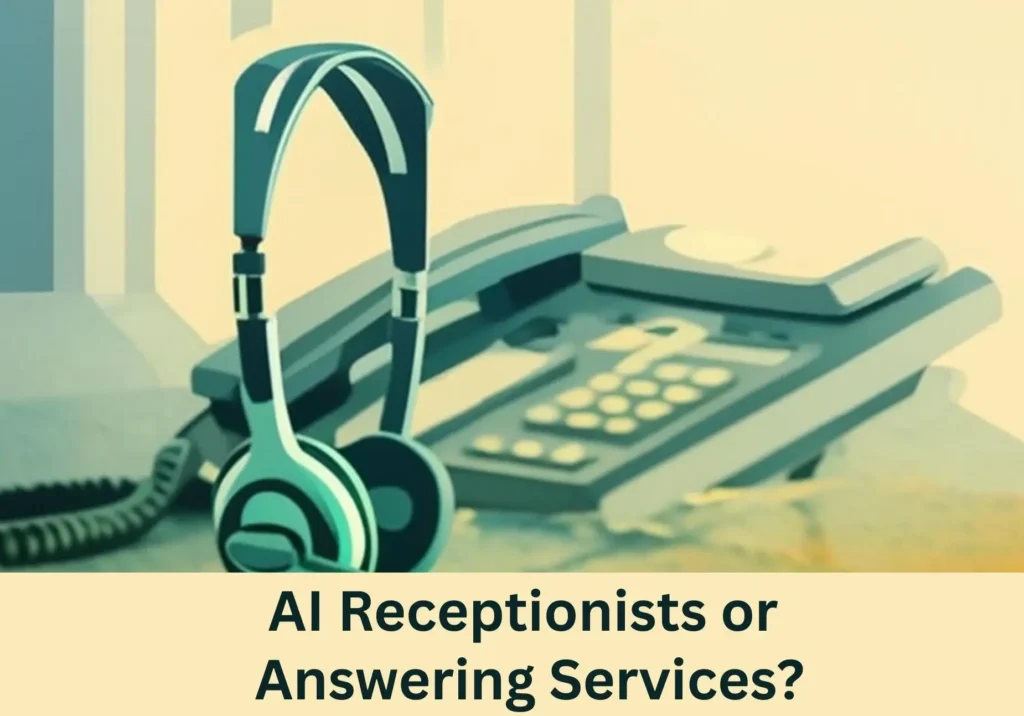
Let’s break down everything you need to know about AI receptionists versus traditional answering services.
CONTENTS
What Exactly Are We Comparing?
Before we dive into the nitty-gritty, let’s get clear on what we’re actually talking about.
Traditional answering services are real people who answer your calls remotely. They work from call centers, follow scripts you provide, and handle your calls when you can’t. Think of them as outsourced human receptionists.
AI receptionists are software programs powered by artificial intelligence that can answer calls, understand what callers are saying, and respond appropriately. They use natural language processing and speech recognition technologies to have conversations that feel surprisingly human.
The technology gap between these options has shrunk dramatically. Modern AI receptionists can handle complex conversations, understand different accents, and even detect emotional cues in a caller’s voice.
The Cost Factor
Let’s talk money because that’s probably your first concern.
Traditional Answering Service Costs
The team at Dial Zara broke down how traditional services typically charge in one of these ways:
- Per-minute pricing: Medical answering services cost between $0.70 to $1.20 per minute of receptionist time
- Monthly packages: Most popular plans range from $295 to $395 per month
- Budget options: Basic services start around $49 monthly for minimal call volume
But here’s what they don’t tell you upfront. Those prices often exclude:
- Setup fees
- Holiday and weekend surcharges
- Overage charges when you exceed your plan limits
- Custom scripting fees
AI Receptionist Investment
AI receptionists work differently. You’re typically looking at:
- Setup costs: One-time implementation and training
- Monthly subscription: Usually flat-rate pricing
- Integration fees: Connecting to your existing systems
The real kicker? AI can potentially save you $250,000 over five years compared to hiring full-time staff. Even when compared to answering services, the math often favors AI for businesses with moderate to high call volumes.

When Your Business Never Sleeps
You know that feeling when you realize you missed an important call?
Traditional answering services help, but they’re not perfect.
The 24/7 Reality Check
AI doesn’t need sleep, lunch breaks, or vacations. It answers calls consistently, whether it’s Christmas morning or during a blizzard that keeps human operators home.
Traditional services claim 24/7 availability, but reality is messier. Operators call in sick. Holidays mean skeleton crews. Major weather events can shut down call centers entirely.
Your AI receptionist? It’s ready to work every single day, handling each call with the same level of professionalism as the first one.
Consistency Matters
Human operators have good days and bad days. They might be friendly in the morning but tired and short by evening. They might handle your industry’s specific questions perfectly one day and stumble the next.
AI receptionists like Smith.ai deliver the same quality every time. They don’t have mood swings, personal problems, or fatigue affecting their performance.

The Human Touch vs. Digital Efficiency
This is where things get interesting. The gap between human and AI interaction is closing fast, but differences remain.
What Humans Do Best
Traditional services excel at handling difficult, emotional situations. When someone’s angry, scared, or dealing with a crisis, human empathy often works better than programmed responses.
Human operators can:
- Read between the lines of what someone’s really asking
- Provide genuine emotional support
- Handle completely unexpected situations with creativity
- Build personal rapport with frequent callers
Where AI Shines
Modern AI receptionists aren’t the robotic voices you remember from years past. Today’s systems use natural language processing to understand caller intent regardless of exact phrasing.
AI advantages include:
- Perfect accuracy: No misheard names or garbled messages
- Instant access: Complete information retrieval in seconds
- Multilingual support: Switch between languages seamlessly
- Integration power: Direct connection to your CRM, scheduling, and other systems
The technology has evolved to where NLP enhances voice recognition by accurately interpreting diverse accents, dialects, and everyday phrases. Your AI receptionist can understand a Southern drawl as easily as a Boston accent.
Industry-Specific Considerations
Not every business has the same needs. Your industry plays a huge role in which option works better.
When AI Makes Perfect Sense
E-commerce and retail: Customers want quick answers about orders, returns, and store hours. AI handles these inquiries perfectly and can even process simple transactions.
Professional services: Appointment scheduling, basic service information, and lead qualification work beautifully with AI systems.
Real estate: Property inquiries, showing schedules, and basic market information are ideal AI applications.
For businesses implementing a full AI growth infrastructure, an AI receptionist often becomes a natural extension of existing automation.
When Humans Win
- Healthcare: While AI can handle appointments, complex medical concerns often require human judgment and empathy.
- Legal services: Sensitive legal matters and crisis situations typically need human intervention.
- Financial services: High-stakes financial decisions and emotional money conversations often benefit from human understanding.
- Emergency services: When people are in crisis, human connection becomes critical.
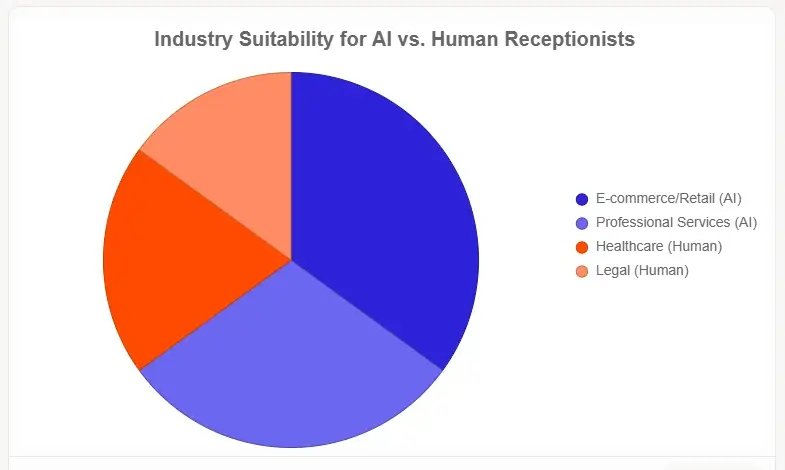
What Can Each Option Actually Do?
Let’s get specific about what you’re actually getting with each option.
AI Receptionist Features
Modern AI systems come packed with capabilities that would have seemed like science fiction just a few years ago:
- Advanced conversation abilities: Virtual agents can provide human-level reasoning and maintain natural conversational tone to help customers get answers quickly.
- Voice customization: Dozens of life-like voices, styles, and accents, including options to clone your own recorded voice for brand consistency.
- Smart routing: AI can analyze caller needs and transfer to the right department or person automatically.
- CRM integration: Instant access to customer history, preferences, and previous interactions.
- Appointment scheduling: Direct booking into your calendar system with conflict detection.
Traditional Service Capabilities
Human operators bring their own set of strengths:
- Complex problem-solving: Humans can navigate unusual situations that fall outside programmed responses.
- Emotional intelligence: Reading tone, providing comfort, and adapting communication style based on caller mood.
- Flexibility: Ability to handle requests that don’t fit standard procedures.
- Industry expertise: Experienced operators can develop deep knowledge of your specific business needs.

The Implementation Reality Check
Choosing between AI and human services isn’t just about features, it’s about what actually works in your daily operations.
Getting Started with AI
AI implementation typically involves:
- System setup and integration with your existing phone system
- Training the AI on your specific business information
- Testing and refinement to handle your most common scenarios
- Ongoing optimization based on real-world performance
The process usually takes 2-4 weeks, depending on complexity.
Many businesses are surprised by how quickly AI learns their specific needs.
Traditional Service Onboarding
Setting up with an answering service involves:
- Service agreement and pricing negotiations
- Script development for common scenarios
- Operator training on your business specifics
- Quality monitoring and feedback loops
This process typically takes 1-2 weeks but requires ongoing management to maintain quality.
Performance Metrics That Actually Matter
How do you know which option is working better for your business?
Track these key metrics:
Call Handling Metrics
- Answer rate: Percentage of calls actually answered
- Average response time: How quickly calls are picked up
- Call resolution rate: Percentage resolved without transfers
- Customer satisfaction scores: Direct feedback from callers
Business Impact Metrics
- Lead conversion rate: How many calls turn into customers
- Appointment booking rate: Scheduling effectiveness
- Cost per call handled: True cost efficiency
- Revenue attribution: Business generated from phone interactions
Most businesses find that AI excels at consistency metrics, while humans often score higher on complex problem resolution.
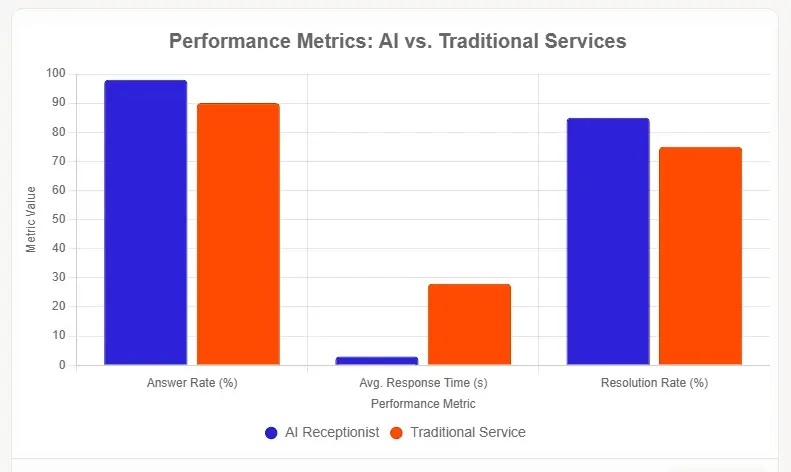
The Hybrid Approach
Here’s something most comparisons miss: you don’t have to pick just one option.
Many businesses are using a mix of both options, leveraging the strengths of each while avoiding their weaknesses.
Smart Hybrid Strategies
- Tier-based handling: AI handles routine inquiries while humans take complex calls. AI sales agents can streamline the initial process before transferring qualified leads to human staff.
- Time-based switching: AI covers after-hours and weekends while humans handle business hours.
- Skill-based routing: Route calls based on complexity, with AI handling straightforward requests and humans managing sensitive situations.
Making the Decision: Your Business-Specific Factors
The right choice depends on several factors specific to your situation:
Choose AI Receptionists If:
- You have high call volume with repetitive inquiries
- Budget constraints make human services challenging
- You need true 24/7 availability
- Integration with existing systems is important
- Your industry suits automated responses
Many businesses are discovering the benefits of AI receptionists is far exceeding their expectations for handling routine business operations.
Choose Traditional Services If:
- Your calls frequently involve complex, emotional situations
- Industry regulations require human oversight
- Your business model depends on personal relationship building
- Call volume is relatively low with high complexity
- Budget allows for premium human service
Consider the Hybrid Model If:
- You want the best of both worlds
- Call types vary significantly in complexity
- You’re testing AI capabilities before full commitment
- Peak hours require different handling than off-hours
Future-Proofing Your Decision
Technology moves fast. What works today might not be optimal next year.
AI Development Trends
The AI receptionist space is evolving rapidly. At least 5 new products debuted since the beginning of the year, showing intense innovation and competition.
Emerging capabilities include:
- Emotion detection: AI that responds to caller mood
- Predictive responses: Anticipating customer needs
- Advanced integration: Deeper connections with business systems
- Multi-channel support: Handling calls, texts, and chats uniformly
Traditional Service Evolution
Human answering services aren’t standing still either. Many are incorporating AI tools to enhance their human operators, creating hybrid solutions that combine human judgment with AI efficiency.
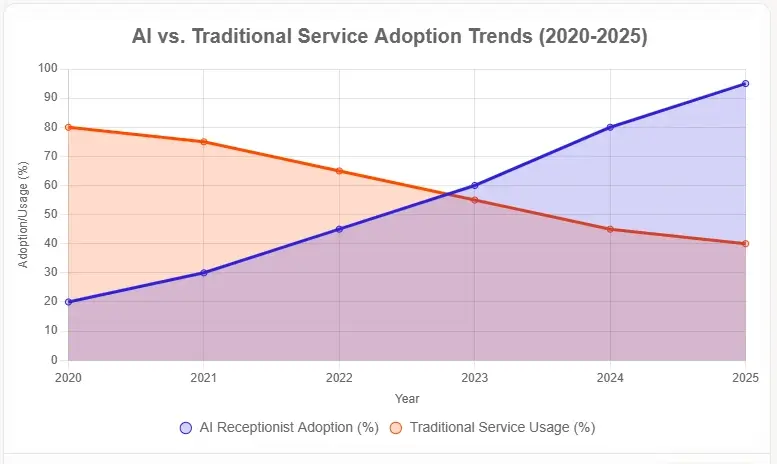
Integration Considerations
Whichever option you choose needs to work with your existing business systems.
Technical Integration
AI systems typically offer:
- API connections to CRM systems
- Calendar integration for scheduling
- Database connections for customer lookup
- Webhook support for custom integrations
Traditional services usually provide:
- Email notifications for messages
- Web portals for message management
- Basic CRM integrations
- Phone tree setup assistance
For businesses already using AI cold calling systems, adding an AI receptionist often creates powerful synergies in customer data and interaction management.
Staff Training Requirements
AI implementation requires:
- Admin training for system management
- Basic troubleshooting knowledge
- Integration management skills
- Performance monitoring capabilities
Traditional service management needs:
- Regular quality reviews
- Script updates and revisions
- Operator feedback and training
- Service level monitoring
Cost-Benefit Analysis Framework
Here’s a simple framework to evaluate options for your specific situation:
Calculate Your Current Costs
- Missed call impact: Estimate revenue lost from unanswered calls
- Staff time: Hours spent on routine phone tasks
- Current solution costs: Existing answering service or staff time
- Opportunity costs: What could staff do instead of answering phones?
Project Solution Costs
- Implementation: Setup and integration expenses
- Monthly operations: Subscription or service fees
- Maintenance: Ongoing optimization and management
- Training: Staff education and adaptation time
Measure Intangible Benefits
- Brand consistency: Uniform service quality
- Customer satisfaction: Improved experience metrics
- Staff satisfaction: Reduced interruption and stress
- Scalability: Ability to handle growth
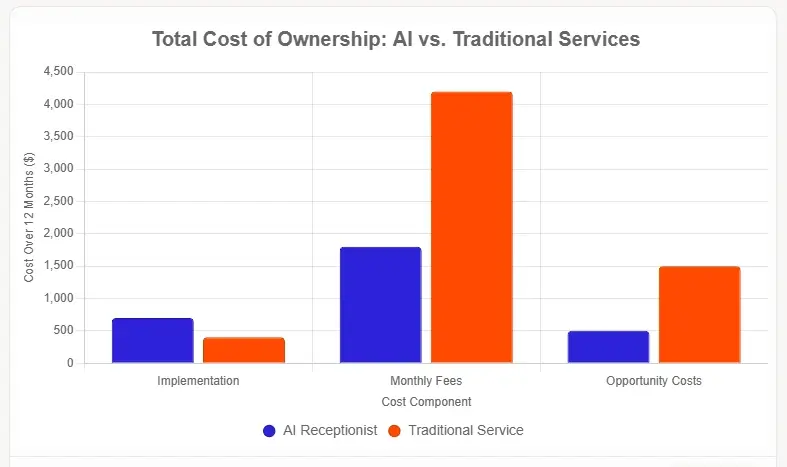
Making Your Final Decision
After weighing all these factors, your decision should align with your business goals, budget, and customer expectations.
Questions to Ask Yourself
- What percentage of your calls could be handled by an AI system?
- How important is the human touch to your customer relationships?
- What’s your budget for both initial implementation and ongoing costs?
- How much time can you invest in setup and optimization?
- What are your growth plans, and how will call volume change?
The Bottom Line
Neither AI receptionists nor traditional answering services are inherently better. The best choice depends entirely on your specific business needs, customer expectations, and operational goals.
AI receptionists excel at consistency, availability, and cost-effectiveness for routine tasks. Traditional services shine in complex, emotional, or highly specialized interactions.
The businesses seeing the most success are those that carefully evaluate their specific needs rather than following industry trends blindly.
Common Mistakes and How to Avoid Them
After helping dozens of businesses navigate this decision, we’ve seen the same costly mistakes repeated over and over.
Here’s how to avoid the biggest pitfalls.
The “Set It and Forget It” Trap
The Mistake: Assuming AI receptionists work perfectly from day one without ongoing optimization.
Many businesses implement AI systems expecting them to work flawlessly immediately. Reality check: even the best AI needs fine-tuning based on your actual call patterns.
How to Avoid It: Plan for a 30-60 day optimization period. Monitor calls, identify areas where the AI struggles, and work with your provider to improve responses. One client saw their AI accuracy jump from 78% to 94% after just three weeks of active refinement.
Underestimating Integration Complexity
The Mistake: Choosing a solution that doesn’t play nice with your existing systems.
You’d be surprised how many businesses pick an AI receptionist that can’t connect to their CRM, creating more work instead of less. Or they choose a traditional service that requires manual data entry for every call.
How to Avoid It: Map out your current tech stack before evaluating options. Ask specific questions about integrations during demos. Request a technical consultation to identify potential conflicts before signing contracts.
The “Cheapest Option” Fallacy
The Mistake: Focusing only on monthly costs while ignoring total cost of ownership.
That $99/month AI solution might seem attractive until you discover it charges extra for every feature you actually need. Similarly, that budget answering service might nickel-and-dime you with overage fees and holiday surcharges.
How to Avoid It: Calculate true costs over 12 months, including:
- Setup and implementation fees
- Integration costs
- Overage charges
- Feature upgrades
- Training time investment
Ask providers for a detailed cost breakdown based on your actual usage patterns.
Inadequate Testing and Evaluation
The Mistake: Making decisions based on polished sales demos instead of real-world performance.
Sales demos are scripted to show the best-case scenario. They don’t reveal how the system handles your grumpy Monday morning callers or unusual requests specific to your industry.
How to Avoid It: Insist on extended trial periods with real calls. Set up test scenarios that match your actual call types. Have different team members interact with the system. One business discovered their chosen AI couldn’t handle their specific appointment scheduling requirements only after going live.
Ignoring Your Team’s Concerns
The Mistake: Implementing solutions without getting buy-in from staff who will work with the system daily.
Your receptionist or office manager knows call patterns better than anyone. Dismissing their concerns often leads to resistance and poor adoption.
How to Avoid It: Involve key staff in the evaluation process. Address their concerns directly. Explain how the new system will make their jobs easier, not replace them. Provide adequate training and support during transition.
Overlooking Compliance Requirements
The Mistake: Choosing solutions that don’t meet industry-specific regulations.
US healthcare businesses need HIPAA compliance just like Canada needs PIPEDA and PHIPA. Financial services require specific data security measures. Legal firms have client confidentiality requirements. Generic solutions often fall short.
How to Avoid It: Identify your compliance requirements before evaluating options. Ask providers for detailed compliance documentation. Verify certifications and security measures. Don’t take verbal assurances – get compliance guarantees in writing.
The “Feature Overload” Problem
The Mistake: Choosing solutions based on impressive feature lists rather than actual needs.
That AI system with 50 features sounds amazing until you realize you only need five of them and they don’t work well. You’re paying for complexity you don’t need.
How to Avoid It: List your must-have features before shopping. Prioritize solutions that excel at your core needs rather than those with the longest feature lists. Sometimes simpler is better.
Unrealistic Timeline Expectations
The Mistake: Expecting immediate results without allowing adequate implementation time.
Whether you choose AI or human services, there’s always a learning curve. Rushing implementation often leads to poor performance and frustrated customers.
How to Avoid It: Plan for gradual rollout. Start with less critical call types or off-hours coverage. Allow time for training, testing, and refinement. Set realistic expectations with your team and customers about the transition period.
Failing to Plan for Growth
The Mistake: Choosing solutions that work for current needs but can’t scale with your business.
That perfect answering service might struggle when your call volume doubles. That AI system might not handle the complexity of your expanded service offerings.
How to Avoid It: Discuss growth plans with providers. Understand how costs and capabilities scale. Ask about upgrade paths and additional features. Plan for where you’ll be in 2-3 years, not just where you are today.
The “One Size Fits All” Assumption
The Mistake: Assuming the same solution works for all call types and departments.
Your sales calls might be perfect for AI handling, while your customer service calls need human touch. Forcing everything through one solution often creates problems.
How to Avoid It: Consider hybrid approaches from the start. Map different call types to appropriate handling methods. Don’t be afraid to use multiple solutions if it serves your customers better.
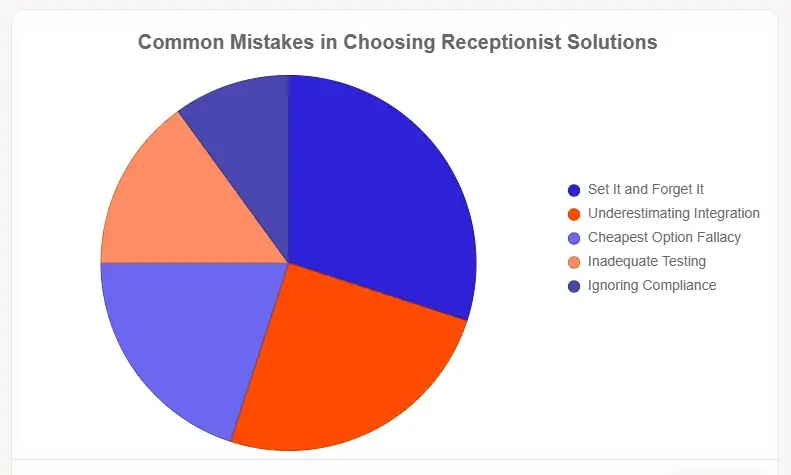
Taking the Next Step
Ready to move forward? Here’s your action plan:
- Audit your current call patterns – Track volume, types, and complexity for at least a week
- Calculate your true costs – Include missed opportunities and staff time
- Test options – Many providers offer trial periods or demos
- Start small – Consider a hybrid approach or limited implementation
- Monitor and adjust – No decision is permanent; optimize based on results
The phone is ringing. Your customers are calling. The question isn’t whether you need help answering, it’s which solution will help your business thrive in an increasingly connected world.
Whether you choose AI efficiency, human empathy, or a combination of both, the most important step is taking action. Your customers are waiting, and the right solution is out there for your business.
FAQs
How long does it take to set up an AI receptionist compared to a traditional answering service?
Setting up an AI receptionist typically takes 2-4 weeks, including integration with your phone system and training on your business needs. Traditional answering services usually require 1-2 weeks for onboarding, including script development and operator training. AI setups may take slightly longer due to technical integrations, but they often require less ongoing management than human services.
Can AI receptionists handle complex or emotional customer calls effectively?
AI receptionists excel at routine tasks like scheduling, answering FAQs, and processing orders, but they may struggle with highly emotional or complex situations. Modern AI systems use natural language processing to understand diverse accents and intents, but for scenarios requiring deep empathy or creative problem-solving, human operators or a hybrid approach are often better suited.
What’s the biggest cost-saving benefit of choosing an AI receptionist over a traditional service?
AI receptionists typically offer flat-rate pricing, which can save businesses with moderate to high call volumes up to $250,000 over five years compared to hiring full-time staff or paying per-minute rates for traditional services. The biggest savings come from 24/7 availability without overtime or holiday surcharges and reduced staff time on routine calls.
How do I know if a hybrid approach is right for my business?
A hybrid approach works best if your business has a mix of routine inquiries (e.g., scheduling, order status) and complex calls (e.g., emotional or industry-specific issues). It’s ideal for businesses wanting AI’s cost-efficiency and consistency for simple tasks while retaining human operators for nuanced interactions. Test a hybrid model if your call volume varies or you’re transitioning to AI gradually.









